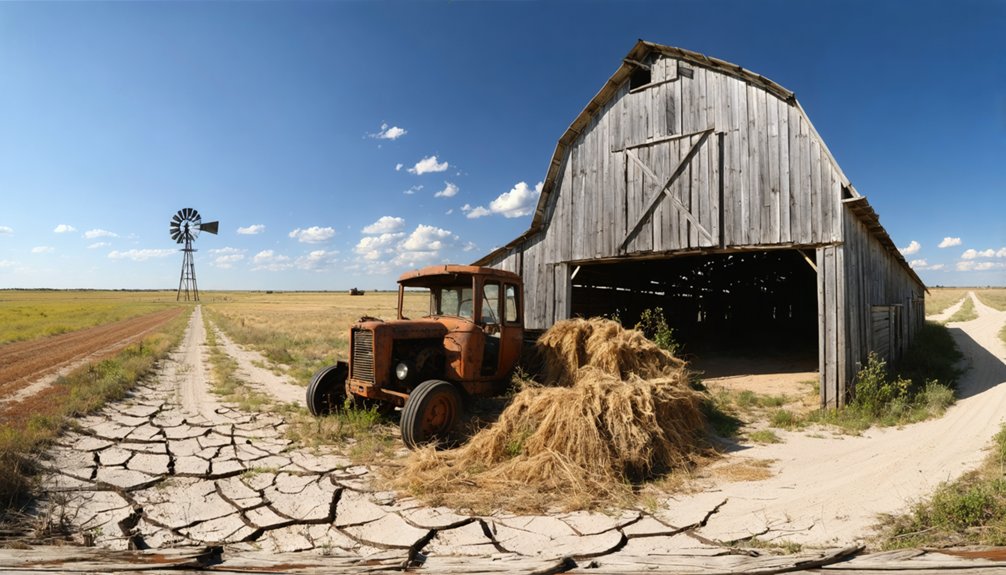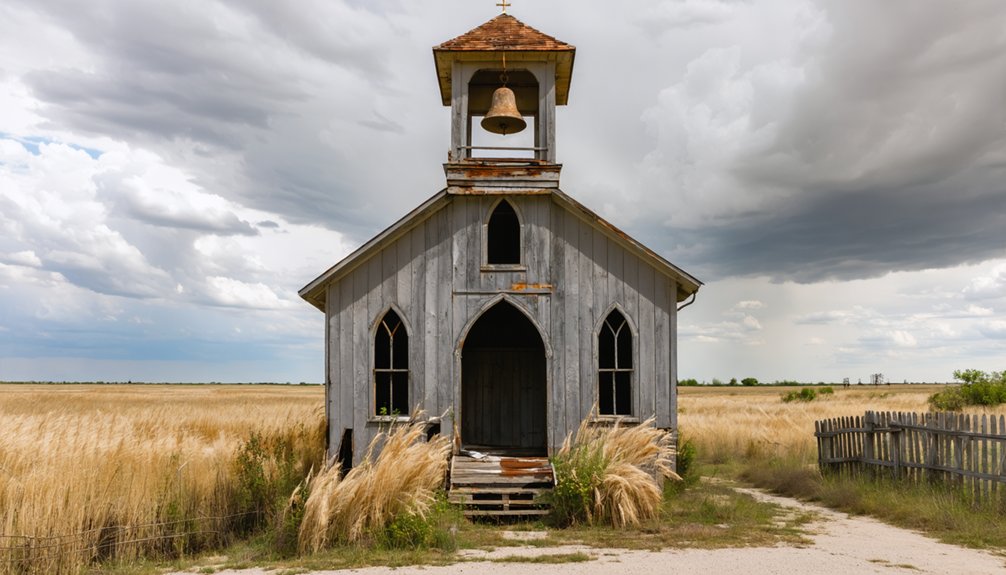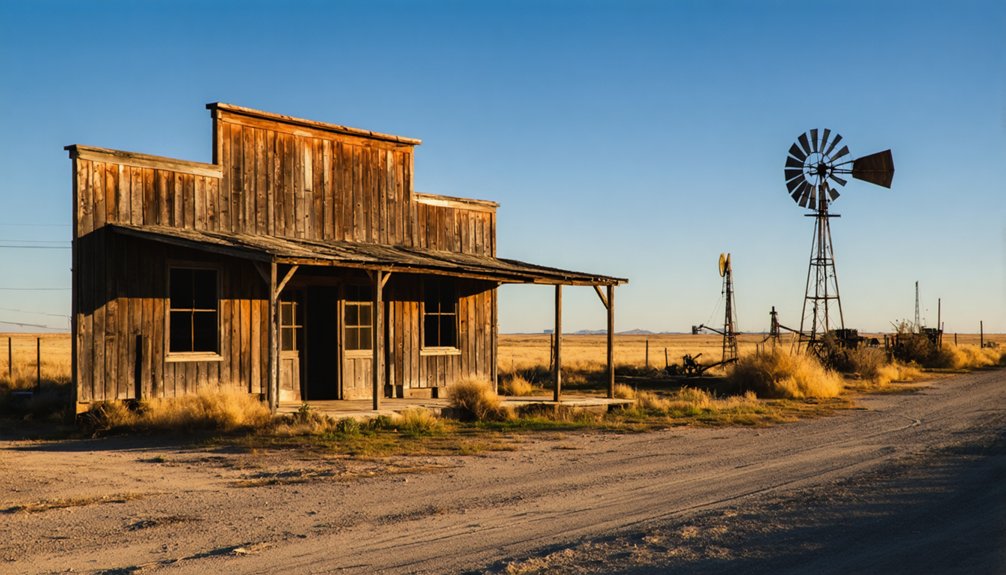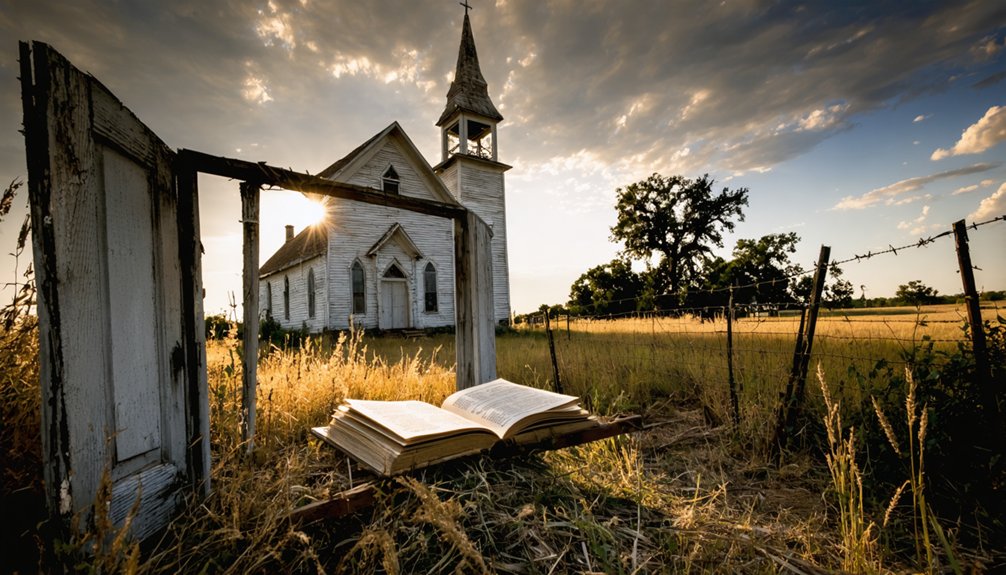You’ll find Upland’s ghostly remnants 10 miles north of Rankin in Upton County, Texas. This former county seat thrived briefly from 1910 until the 1920s, boasting a stone courthouse, jail, and population of 200 at its peak. The town’s fate changed when the Missouri, Kansas, and Texas Railroad chose nearby Rankin for its station. While most structures have vanished, the town’s rich history as a frontier settlement holds fascinating untold stories.
Key Takeaways
- Upland, Texas was founded in 1908 as Upton County’s first seat, reaching its peak population of 200 residents in 1929.
- The town declined after the Missouri, Kansas, and Texas Railroad bypassed it for Rankin in 1914.
- A stone courthouse and jail were built in 1913 for $22,000, marking Upland’s brief prominence as county seat.
- The post office closed in 1918 as residents moved away, with only 31 ranches and farms remaining by 1920.
- Environmental challenges, including severe drought and limited water resources, contributed to the town’s ultimate abandonment.
The Birth of a Frontier County Seat
Nearly every Texas frontier town has an origin story, but Upland’s emergence as Upton County’s first seat of government followed a carefully planned trajectory.
You’ll find Upland’s founding was strategically orchestrated in 1908 when Henry Halff and his son platted the townsite near the bustling Butterfield Overland Mail route.
The town established a public school district in 1908 to serve the growing population.
However, the town’s prominence was short-lived when the Kansas City Orient Railway bypassed Upland, leading residents to relocate to the newly established Rankin in 1911.
Early Development and Promise
Upland’s selection as Upton County’s first seat of government in 1910 brought tremendous optimism to your pioneering community, with plans quickly drawn up for a permanent stone courthouse.
The county invested twenty-two thousand dollars to construct the courthouse and jail in 1913.
The Missouri, Kansas, and Texas Railroad brought vital transportation access to the area in 1914.
You’ll find it interesting that town leaders had actively pursued a rail station connection, hoping to secure Upland’s position as the region’s primary transportation hub.
These development dreams would’ve materialized differently if the Kansas City, Mexico and Orient Railway hadn’t ultimately chosen nearby Rankin for its station in 1911, a decision that would reshape your town’s destiny.
County Seat Selection Process
When Upton County officially organized in 1910, the selection of its first county seat marked a pivotal moment in the region’s development.
You’ll find that Upland’s designation as county seat wasn’t just a random choice – it met specific selection criteria that aimed to serve the community’s needs. The site’s location near the geographic center of the county fulfilled state requirements for accessibility, while its position along the Butterfield Overland Mail route promised essential transportation connections. The region’s elevation above sea level ranging from 2,300 to 3,000 feet provided ideal conditions for settlement.
The Halff family’s vision for Upland included establishing the town’s first school in 1908 and platting the community that same year.
When they built the stone courthouse after the county seat selection, it seemed Upland would flourish as your county’s administrative heart. The federal government’s establishment of a post office in 1907 further legitimized these aspirations. Before the railroad’s arrival, Upland served as the only post office in the entire county.
Rail Station Development Plans
The arrival of the Kansas City, Mexico & Orient Railroad in 1911 sparked a dramatic shift in Upton County’s development path.
As you’d expect, rail station logistics became a significant focus, with planners carefully selecting locations that could support both passenger service and essential freight transportation needs despite the region’s challenging water scarcity. Much like Mertens Station, which was built near Richland Creek’s water, many of these stations were eventually repurposed for various community uses. Similar to the historical depot trend, many of these stations were eventually repurposed for various community uses.
You’ll find it interesting that the railroad’s impact went far beyond just moving people and goods. It transformed settlement patterns, drawing folks away from Upland toward Rankin, where the rail line promised new opportunities.
While early agricultural dreams didn’t pan out due to poor soil conditions, the rail infrastructure proved indispensable when oil was discovered.
The Santa Fe Railroad‘s later involvement, particularly in McCamey, guaranteed that our region’s resources could reach broader markets efficiently.
Life in Early Upland
In early Upland’s pioneer days, you’d find ranchers and farmers heading out before dawn to tend their livestock and attempt crop cultivation in the challenging soil conditions.
You could always spot neighbors gathering at the stone courthouse and post office, which served as the heart of community life and local governance.
Children would make their way to the schoolhouse each morning, where education became a cornerstone of the town’s identity from its very first year.
Daily Pioneer Activities
Life in early Upland centered around the demanding routines of ranching and farming, as settlers worked tirelessly to establish themselves in the harsh West Texas environment. Your pioneer routines would’ve included tending to cattle, horses, and sheep, with World War I’s high market prices driving livestock production.
You’d spend your days drilling wells for water, mending fences, and managing your herds with shepherd dogs. Agricultural practices proved challenging, as poor soil conditions and persistent drought forced many farmers to abandon crops by 1912.
You’d rely on community cooperation for harvesting and livestock care, while maintaining your household garden to supplement your family’s diet. Daily survival meant adapting to the unforgiving climate, sharing labor with neighbors, and making the most of limited resources.
Community Gathering Places
Social connections in early Upland flourished through five distinct types of gathering places that formed the heart of community life.
You’d find religious meetings at churches where community bonding extended beyond worship to include charity events and education.
The general store and post office served as hubs for trading news and goods, while saloons provided space for men’s social interactions.
When formal decisions needed making, you’d head to temporary public halls or the courthouse in Midkiff.
For recreation, you could join your neighbors at seasonal festivals, barn dances, or community picnics, much like today’s Community Center gatherings that bring residents together for celebrations and events.
These gathering spots weren’t just places – they were the threads that wove together the fabric of daily life, creating lasting relationships through shared experiences and mutual support.
The town reached its social peak when 200 residents populated the area in 1929, supporting multiple hotels and cafes where people would regularly congregate.
The Railroad’s Fateful Decision
When the Kansas City, Mexico and Orient Railway reached Rankin in fall 1911, it sealed Upland’s fate by bypassing the town completely.
Originally slated to be a stop on the St. Louis to Chihuahua line, you’ll find that Upland’s exclusion from the final railroad plans changed everything. The railroad’s impact triggered immediate migration patterns as residents and businesses couldn’t survive without rail access.
You can trace Upland’s rapid decline through the relocations that followed. The town’s hotel moved to Rankin in 1912, followed by the Upland Roundup newspaper.
Agricultural Struggles and Environmental Challenges

Throughout Upton County’s early development, agricultural ventures faced formidable environmental obstacles that would shape the region’s destiny.
You’d have found the soil particularly challenging for crop viability, with most early settlers quickly discovering that traditional farming wouldn’t sustain their dreams.
While underground water existed, it’d only support light irrigation, limiting agricultural options.
The Great Migration to Rankin
During Mexico’s changeover from Spanish rule in 1821, waves of determined settlers began their journey toward what would become Rankin, Texas. The migration patterns showed families moving in connected groups, often sharing religious beliefs and community values.
You’ll find that Protestant missionaries like Melinda Rankin played a significant role in shaping the cultural influence of the region.
- Land grants attracted settlers from states like Tennessee, with pioneers receiving property through Mexican government approvals.
- Religious communities formed tight-knit social networks, supporting each other through the challenges of resettlement.
- Families navigated complex political shifts as the territory changed from Mexican to Texan to U.S. control.
Despite environmental hazards and limited resources, these determined settlers established lasting communities that would shape Rankin’s future development.
Notable Buildings and Landmarks

The heart of Upland’s civic pride once stood in the form of its 1911 stone courthouse, a two-story structure that marked the town’s brief status as Upton County’s seat.
In 1911, Upland’s stone courthouse rose as a symbol of progress, marking its short-lived glory as county seat.
You’ll find historic remnants of this architectural significance scattered across the landscape today, though most buildings have succumbed to time. The 1908 schoolhouse once educated the town’s youth, while other civic buildings dotted the landscape near the anticipated railroad station and Butterfield stage route.
Beyond Upland’s boundaries, you’ll discover traces of the Barrett Ranch, Benedum Camp, and Benedum Oil Field – proof of the region’s ranching and oil heritage.
While nature has reclaimed most structures, you can visit the courthouse’s historical marker in Rankin, where it stands as a reminder of Upland’s fleeting prominence.
The Final Years of Settlement
You’ll find the final chapter of Upland’s story begins around 1911-1912, when most families made the calculated decision to relocate to nearby Rankin following the arrival of the railroad there.
The town’s post office, which had served the community since 1907, couldn’t sustain operations as the population dwindled to just 253 residents by 1920.
While some hardy ranchers maintained their operations through World War I’s livestock boom, the discovery of oil in other parts of Upton County by 1926 drew away the last remaining settlers, leaving Upland’s buildings to slowly decay on private ranchland.
Post Office Closes Down
Facing mounting pressures from drought and railroad bypasses, Upland’s post office closed its doors in 1918, marking a final chapter in the town’s brief history.
You’d have witnessed the postal service decline mirror the broader community abandonment, as most residents had already relocated to Rankin where the railroad brought new opportunities.
The closure marked the end of an era that began in 1907 when Edward B. Coatwright first served your community as postmaster.
Here’s what sealed Upland’s fate:
- The Orient Railroad’s southern route bypassed the town in 1911
- Severe drought in the 1910s devastated local agriculture
- Key businesses, including the hotel and newspaper, physically moved to Rankin
Remaining Families Depart
As poor soil quality and persistent drought conditions plagued local farmers around 1911-1912, Upland’s once-hopeful settlers began their gradual exodus to more promising locations.
You’d have seen families pulling up stakes, many heading to nearby Rankin where the new railroad promised better opportunities. By 1920, only 31 ranches and farms remained in the area.
The discovery of oil in 1926 dealt the final blow to Upland’s remaining settlers.
As George McCamey’s strike sparked a black gold rush, about 700 people flocked to the newly established oil town, leaving Upland’s agricultural dreams behind.
The community’s decline accelerated as families sought education and services elsewhere, and your once-bustling courthouse stood empty, a silent indicator to Upland’s fading significance.
Geographical Significance and Location

Located at coordinates 31°21′59″N and 101°58′50″W, the ghost town of Upland sits 10 miles north of Rankin in Upton County, Texas.
You’ll find this historic settlement perched at 2,688 feet above sea level, nestled within the rugged Edwards Plateau region where geographical features shaped its destiny.
If you’re exploring Upland’s location history, you’ll want to note these key aspects:
- The town’s strategic position made it ideal for the planned St. Louis to Chihuahua rail line
- The surrounding terrain includes dramatic landmarks like King Mountain and Castle Mountain
- The area’s unique limestone outcrops and sandy loam soils support desert-adapted plants like mesquite and cacti
Despite its promising location near historic stage routes, Upland’s harsh semi-arid climate and changing transportation patterns ultimately influenced its abandonment.
Historical Impact on Upton County
The geographical positioning of Upland set the stage for its brief but significant role in shaping Upton County’s early development. You’ll find that as the first county seat in 1910, Upland established fundamental administrative and judicial frameworks that would guide the region’s future.
However, Upland’s decline began when the Kansas City, Mexico and Orient Railway bypassed the town in 1911. This economic shift forced residents and businesses to relocate to Rankin, where rail access promised better opportunities.
Frequently Asked Questions
What Happened to the Original Courthouse Records When Upland Was Abandoned?
You’ll find the court records were safely transferred to Rankin’s courthouse when it became the new county seat in 1915. They’re still available there today for your archival research needs.
Are There Any Surviving Photographs of Upland During Its Peak Years?
Like finding a needle in a haystack, you won’t see many peak-era photos in ghost town archives. While some historical photography might exist at Midland Public Library, published images are primarily post-decline ruins.
Did Any Notable Historical Figures Ever Visit or Stay in Upland?
You won’t find any famous visitors of historical significance in Upland’s records. The town’s brief stint as county seat didn’t attract notable figures before its decline and abandonment.
What Became of the Families Who Initially Founded the Town?
Like tumbleweeds drifting westward, most founding families scattered when oil beckoned in Rankin. You’ll find their descendants either adapted to the petroleum boom or moved on, leaving their ranching legacy behind.
Can Visitors Still Access the Original Townsite of Upland Today?
You can’t freely access the original townsite since it’s on private ranch land. There’s no town preservation or marked access routes – you’ll need permission from current landowners.
References
- https://www.historictexas.net/city/upland-texas
- https://texasbob.com/travel/tbt_stiles.html
- http://genealogytrails.com/tex/bigbend/upton/upland.html
- https://www.tshaonline.org/handbook/entries/upton-county
- https://en.wikipedia.org/wiki/List_of_ghost_towns_in_Texas
- https://www.texasescapes.com/WestTexasTowns/Upland-Texas.htm
- https://www.co.upton.tx.us/page/COUNTY FACTS
- https://www.tshaonline.org/handbook/entries/rankin-tx-upton-county
- http://www.254texascourthouses.net/163-upton-county.html
- https://en.wikipedia.org/wiki/Upton_County



